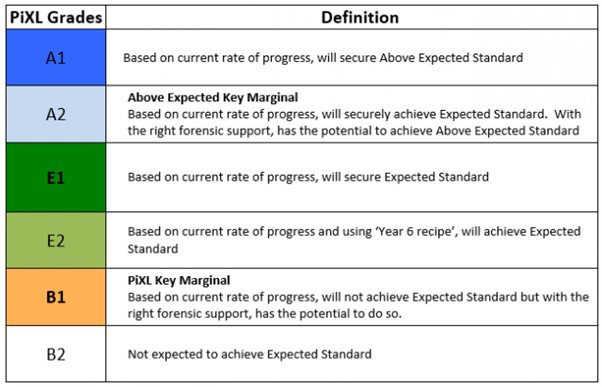Download our FREE smartphone app today!
PiXL
PiXL Assessment Information
Raising Standards Leader (RSL):
The role of the Raising Standards Leader, Miss Daniels, is to ensure the best possible outcomes and progress for all our children across KS1 and KS2. In doing this, the RSL supports staff in their understanding of PIXL and how to use it effectively. The RSL also provides challenge with regards to data and identifying key marginal children. After each round of assessments, the RSL will provide data reports to each year group to assist in identifying those children. The RSL attends pupil progress meetings to provide support and challenge, where necessary.
PIXL Language of Assessment Years 1-5:

PIXL Language of Assessment Year 6:

Termly Assessments:
Years 2-6 complete a PIXL assessment for Reading, Grammar and Maths three times per year. Teachers are responsible for completing and uploading the associated question level analysis (QLA) documents in line with the annual agreed PIXL dates to allow school-to-school comparison.
Year 1 complete this process in the summer term.
It is important to note that all PIXL assessments should be completed on an independent basis as any support given could compromise the data and therefore the children identified as key marginals. Of course, consideration should be given to children who require specialist support so all children can access their assessments, where possible.
Diagnose, Therapy, Test, Revisit (DTTR):
Teachers use the QLA documents to identify specific gaps for individual children, small groups and the whole class. PIXL therapies, specifically designed to address curriculum objectives, are used for their intended audiences. However, it is important to note at this point that PIXL is used among other useful resources, such as Testbase, White Rose and other forms of low stakes quizzes to ensure that children get plenty of opportunities to practise the skills required to achieve specific objectives. PIXL therapy tests are then used to inform teachers if these gaps have been successfully closed or if there is further practise required for particular children. If therapy tests suggest that gaps have been closed, it is imperative that teachers plan in revisiting opportunities across the curriculum to ensure that this learning is securely embedded.
PIXL Grades:
Throughout the academic year, teachers use the DTTR process to monitor pupil progress, (see language of assessment definitions above). However, pupils’ PIXL grades are always updated after an assessment window and will be used to monitor pupils’ progress in our termly pupil progress meetings.
KS2 Progress:
As part of the PIXL administration, end of KS1 assessment is updated annually. This allows each teacher to be fully aware of their pupils’ prior attainment to ensure that this is taken into account when considering which children are key marginals. For example: a pupil in Year 4 who achieved GDS (greater depth) at the end of KS1 in maths and is currently an E1 on PIXL should possibly be identified as a key marginal as their progress is below expected.
Wildly Important Goal (WIG):
Each year group (1-6) uses their PIXL grades to set a WIG at the beginning of each academic year. This should be a realistic, yet ambitious, target for the year group.























